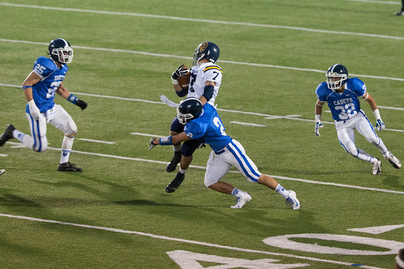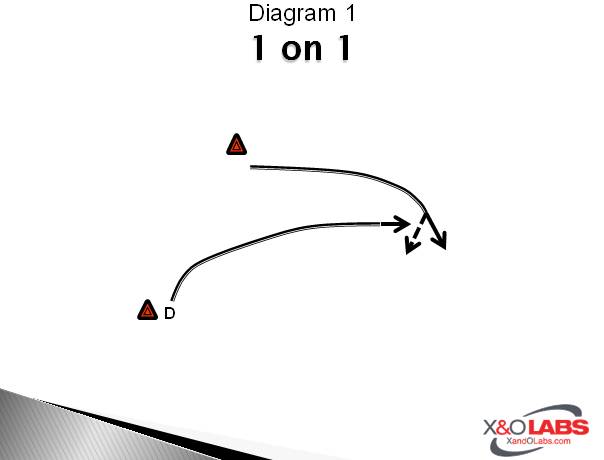By Jason Sedlak
Defensive Coordinator
St. Thomas Academy (MN)
Introduction
 There are very few completely original ideas in the game of football today, and the pursuit angles that we use at Saint Thomas Academy (STA) are a result of a clinic presentation made by Coach Chuck Martin who was at the time, the Grand Valley State University Head Coach. Coach Martin presented the idea that running to a spot at some point down the field where you hope to intersect the ball carrier actuallyprovides more opportunity for big yardage on cutbacks because you are creating space for the ball carrier. This type of angle suggests that you are trying to tackle the ball carrier by yourself and do not have any help on the field. He called it a one on one pursuit angle. He then went on to present the team tackling angles that they used at GVSU and that is the basis of the pursuit angles that we use at STA.
There are very few completely original ideas in the game of football today, and the pursuit angles that we use at Saint Thomas Academy (STA) are a result of a clinic presentation made by Coach Chuck Martin who was at the time, the Grand Valley State University Head Coach. Coach Martin presented the idea that running to a spot at some point down the field where you hope to intersect the ball carrier actuallyprovides more opportunity for big yardage on cutbacks because you are creating space for the ball carrier. This type of angle suggests that you are trying to tackle the ball carrier by yourself and do not have any help on the field. He called it a one on one pursuit angle. He then went on to present the team tackling angles that they used at GVSU and that is the basis of the pursuit angles that we use at STA.
We play an aggressive pressure style defense at STA, and like all defenses, we put a premium on playing team defense and getting as many players to the football as possible on each play. We emphasize speed and want our kids flying to the football without hesitation. One of the foundations of our team defense concept is trust. We don’t want 11 heroes running around the field all trying to make the big play. We want 11 guys who are focused on doing their jobs and trust their teammates to do the same. We feel that the way we pursue to the football emphasizes our team defense and trust concepts.
Identifying Force
Every one of our defensive calls has a primary and secondary force player and it is absolutely necessary that all 11 defenders know and trust that the ball will be turned back to the inside where we have the most help. It is just as important that our force players trust their teammates to pursue aggressively and on the correct angles in order to minimize the offenses effectiveness. We feel that this allows our players to go full throttle to the football because they know, and over time and through repetition, trust that their teammates will turn the ball back to them.
Knowing that we have players assigned to force the ball back to the inside of the field, we teach our players to pursue to the inside or back hip of the ball carrier. The only exceptions to this rule are for the primary force player on the backside of the play who looks for reverse and all misdirection plays coming back his way, and the backside corner who takes an angle towards the far pylon for the “touchdown saving tackle.” The remaining non-force players are on inside out pursuit paths pressing the inside hip of the ball carrier. We feel that this puts them in great position to make a tackle when the force player makes the ball carrier turn back to the inside. Using this general concept, we are trying to restrict the amount of space available to the ball carrier and therefore taking away the big cutback play.
Drilling Pursuit
We conduct at least one, if not all, of the pursuit drills below in practice on a daily basis. Some days we will work through four of the drills in an eight to ten minute pursuit circuit. On other days we will mix these pursuit drills with tackling and take away drills in a skills circuit. We emphasize getting to the football as fast as possible and on the correct path during every one of our practice periods. It doesn’t matter if we are in our pursuit circuit, a unit drill, skelly, or team against scout cards, we are constantly telling our kids to get after the football and to take the correct angles. Like any skill in football, repetition with constant feedback is the key.
1 on 1 Concept Drill

We use this drill in summer practice and the first day or so of two-a-days to introduce and solidify the back hip concept. The ball carrier is to take an outside path and at some point in time try to cutback across the face of the defender. The defender should pursue to the back hip and know that the ball carrier will cut back into his pursuit path. We conduct this drill at ½ to ¾ speed to really solidify the concept and focus on the following coaching points:
- Initial steps should be directly at back hip and bend as the ball carrier turns upfield.
- Do not get out in front of the ball carrier and run to a point in space where he might go.
- Close the distance with the ball carrier as fast as possible.
- Shimmy/breakdown under control as the ball carrier cuts back.
- Never let the ball carrier cross your face.
Check out the film below for a closer look at this drill.









